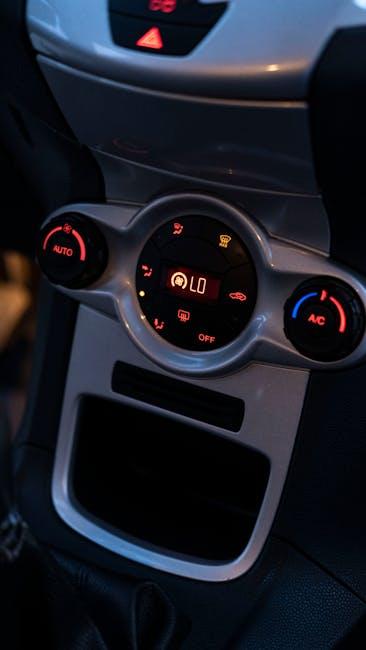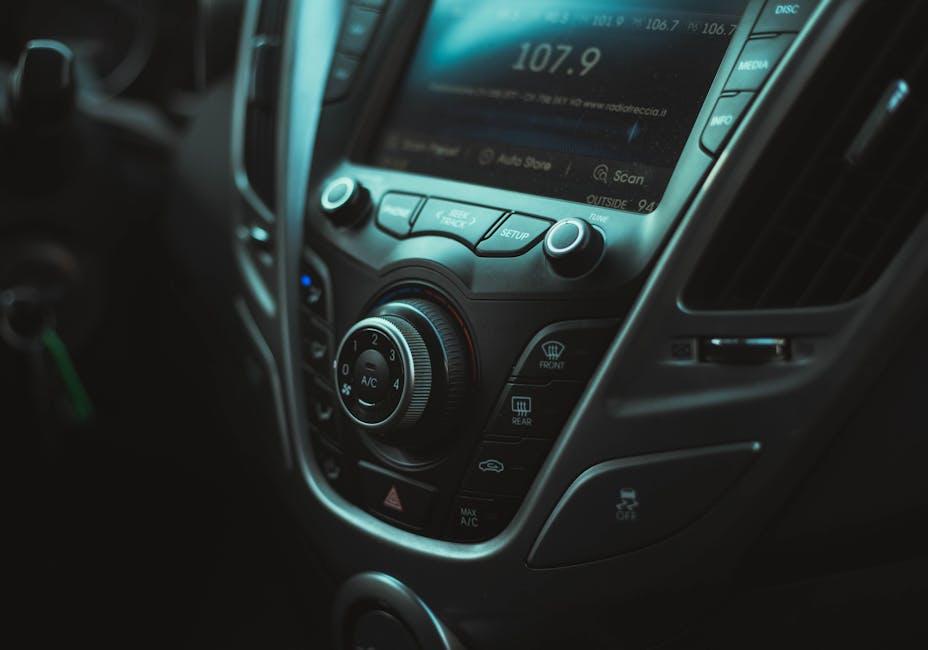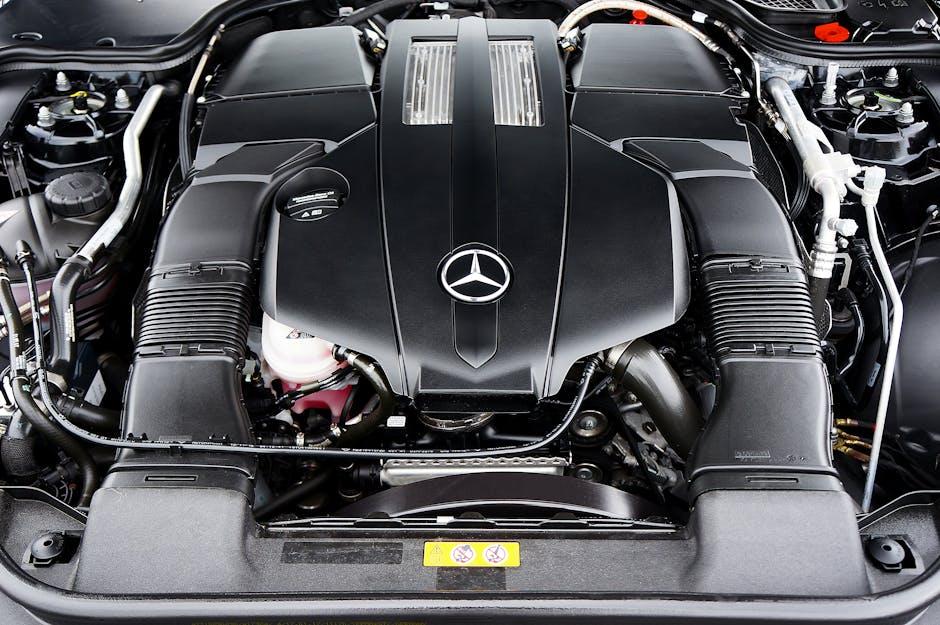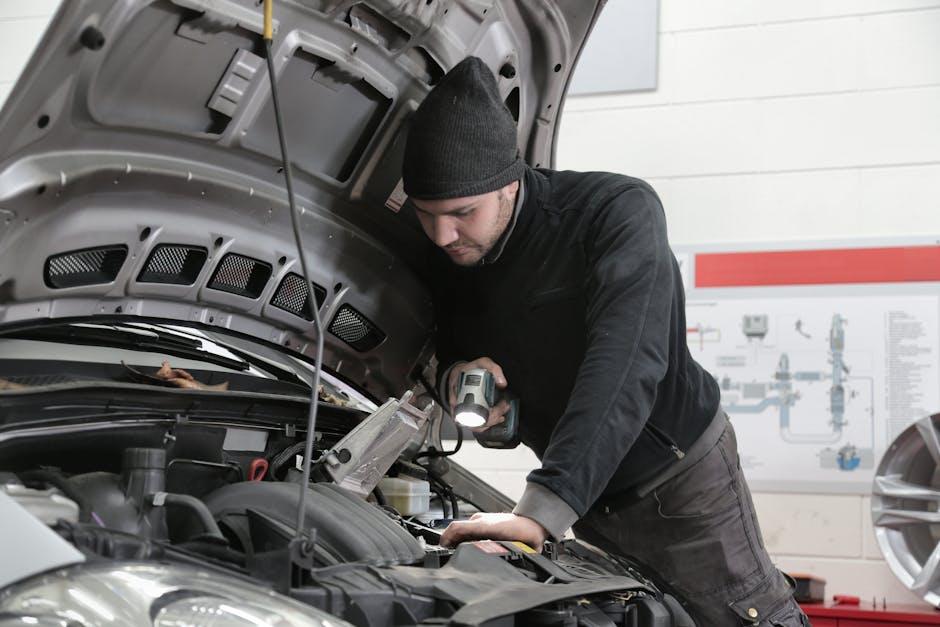When the summer heat rolls in and the sun blazes down, your car’s air conditioning system becomes more than just a luxury—it’s a sanctuary on wheels. But what happens when that cool breeze suddenly turns warm, or worse, stops blowing altogether? Troubleshooting car AC problems can feel like navigating a maze of components and technical jargon. Whether you’re a seasoned driver or a curious DIYer, understanding the basics of how your car’s AC works and knowing how to identify common issues can save you time, money, and discomfort. Let’s dive into the essential steps to diagnose and tackle those stubborn problems, bringing back the chill you need to beat the heat.
Table of Contents
- Understanding Common Causes of Car AC Malfunctions
- Diagnosing Airflow Issues and Blockages
- Checking Refrigerant Levels and Leaks
- Inspecting the AC Compressor and Electrical Components
- Evaluating the Cabin Air Filter and Vents
- Implementing DIY Fixes and When to Seek Professional Help
- Q&A
- Final Thoughts

Understanding Common Causes of Car AC Malfunctions
Car AC systems are intricate, relying on a delicate balance of components and refrigerants to keep your cabin cool. One of the most frequent culprits for malfunction is a refrigerant leak, which can cause the air conditioning to blow warm air instead of cold. These leaks often go unnoticed until the system pressure visibly drops, impacting overall performance. Additionally, a faulty compressor can disrupt the cycle by failing to circulate the refrigerant effectively, leading to a complete breakdown of cooling functionality.
Electrical issues also play a significant role in AC failures. Loose wiring or a damaged fuse can interrupt the power supply to critical components like the blower motor or the AC clutch, resulting in inconsistent operation or complete failure. Moreover, clogged or dirty cabin air filters can reduce airflow, causing the system to work harder and less efficiently. Below is a quick breakdown of common causes and their typical symptoms to help you diagnose problems early:
| Cause | Symptom | Impact |
|---|---|---|
| Refrigerant Leak | Warm air output | Reduced cooling capacity |
| Compressor Failure | Loud noises, no cooling | System shutdown |
| Electrical Faults | Intermittent operation | Unreliable AC function |
| Clogged Air Filter | Weak airflow | Increased strain on system |

Diagnosing Airflow Issues and Blockages
When your car’s AC isn’t blowing cold air as expected, start by inspecting the vents for any obvious dust buildup or debris blockages. Objects like leaves, dirt, or even small critters can obstruct airflow, reducing efficiency. Use a soft brush or compressed air to gently clear the vents and ducts. Don’t forget to check the cabin air filter, as a clogged filter can severely restrict the amount of air passing through, causing the AC to seem weak or ineffective.
For a more thorough diagnosis, observe the blower fan speed and listen closely for any unusual noises that might indicate a malfunctioning motor or a stuck fan blade. Additionally, consider running a simple airflow test at various speed settings to spot inconsistencies. The table below summarizes common symptoms and potential airflow-related causes:
| Symptom | Possible Cause | Quick Fix |
|---|---|---|
| Weak airflow from vents | Dirty cabin air filter | Replace filter |
| No air from certain vents | Blocked ducts or closed vents | Clear obstruction or open vents |
| Rattling noise when AC runs | Loose blower motor parts | Inspect and tighten components |
| AC only works on high fan setting | Blower resistor failing | Replace resistor |

Checking Refrigerant Levels and Leaks
Ensuring your car’s AC system contains the proper amount of refrigerant is crucial for optimal cooling performance. A simple symptom of low refrigerant is if the air blowing from vents feels warm or slightly less cold than usual. To check levels accurately, use a manifold gauge set, which can provide detailed pressure readings for your system’s high and low sides. Remember, overcharging can be just as harmful as having too little refrigerant, potentially leading to compressor damage.
Identifying leaks is equally important since refrigerant loss often results from punctures or worn seals. Visual inspection under the hood combined with a UV dye test helps pinpoint elusive leaks. Here are some key signs and tips for detecting leaks:
- Oil stains: Refrigerant leaks often carry traces of compressor oil, leaving greasy spots on AC components.
- Audible hissing: Listen carefully near AC lines for any faint gas escaping.
- Use of electronic leak detectors: These tools can sense trace amounts of refrigerant in the air around suspected leak points.
| Tool | Purpose | Tip |
|---|---|---|
| Manifold Gauge | Measure refrigerant pressure | Check both high & low sides |
| UV Dye Kit | Spot leaks visually | Use strong UV light for accuracy |
| Electronic Leak Detector | Detect minuscule leaks | Sweep slowly around lines |

Inspecting the AC Compressor and Electrical Components
Begin by checking the AC compressor, the heart of your vehicle’s cooling system. Look for visible signs of wear such as oil leaks, cracks, or unusual noises when the AC is turned on. A spinning compressor clutch indicates it’s engaging properly; if it doesn’t engage, the problem could be internal or electrical. Additionally, inspect the compressor pulley and belt for damage or looseness, as a slipping belt can hinder performance and cause intermittent cooling issues.
Next, assess the electrical components tied to the AC system, including fuses, relays, and wiring connections. Use a multimeter to test voltage continuity in the compressor clutch circuit. Pay attention to the wiring harness and connectors—damaged insulation or corrosion can interrupt electrical flow, resulting in intermittent or complete failure of the AC compressor. Below is a quick reference table for common compressor clutch electrical issues:
| Issue | Possible Cause | Troubleshooting Step |
|---|---|---|
| Compressor clutch doesn’t engage | Blown fuse or faulty relay | Check and replace fuses/relays |
| Intermittent clutch engagement | Loose wiring connection | Inspect and secure connectors |
| Harsh clicking noise | Damaged pulley or worn clutch | Examine and replace parts if needed |

Evaluating the Cabin Air Filter and Vents
Start by inspecting the cabin air filter, often overlooked yet crucial for optimal airflow and air quality. A clogged or dirty filter restricts air passage, resulting in weak cooling and unpleasant odors inside the car. To check it, locate the filter behind the glove box or under the dashboard, then remove and visually assess it for dust buildup, debris, or mold. Replacing the filter regularly, as recommended in your vehicle manual, guarantees fresh and efficient air circulation.
Next, examine the AC vents themselves. Blocked or damaged vents can disrupt the airflow direction and volume, hampering comfort. Make sure vents are fully open, free from obstructions like dirt or small objects, and angled correctly toward the passenger compartment. Consider the following checklist:
- Cleanliness: Wipe vents with a damp cloth or use a soft brush to remove dust.
- Functionality: Adjust vents to ensure they open and close smoothly.
- Placement: Verify that airflow reaches intended areas without being blocked.
| Symptom | Likely Cause | Suggested Action |
|---|---|---|
| Weak airflow | Dirty cabin filter | Replace filter |
| Musty smell | Mold in vents or filter | Clean vents and replace filter |
| Uneven cooling | Blocked or closed vents | Adjust and clean vents |

Implementing DIY Fixes and When to Seek Professional Help
Before calling in the experts, many car AC issues can be managed with some simple DIY techniques. Start by checking the basics: ensure your car’s AC settings are correctly adjusted, inspect the cabin air filter for blockages, and look under the hood for any obvious signs of leaks or worn belts. You might also want to top up the refrigerant if levels are low, but be sure to use the correct type specified in your owner’s manual. These steps can often bring back that refreshing cool breeze without the need for expensive repairs.
However, there are clear signals that it’s time to seek professional assistance. Persistent strange noises, a sudden drop in cooling efficiency despite a full refrigerant tank, and visible fluid leaks under the vehicle point to deeper mechanical or electrical issues. Attempting to fix complex components like compressors or electrical wiring without proper training can worsen the problem or risk injury. Use the table below to quickly gauge when to DIY and when to visit a pro:
| Issue | DIY Fix | Professional Help Needed |
|---|---|---|
| No cooling but fan runs | Check refrigerant level, replace cabin filter | Compressor or refrigerant leaks |
| Strange noises | – | Worn belts or faulty compressor |
| Bad odors | Clean or replace cabin air filter | Mold deep in vents or evaporator |
Q&A
Q&A: How to Troubleshoot Car AC Problems
Q1: Why is my car AC blowing warm air instead of cold?
A1: When your car’s AC is sending out warm air, it’s often a sign of low refrigerant levels. The system needs a specific amount of refrigerant to absorb heat and cool the air. Other causes might include a faulty compressor, a broken blend door actuator, or electrical issues. Checking the refrigerant charge is usually the first step.
Q2: My car AC smells bad when I turn it on. What’s going on?
A2: A foul or musty odor from the vents typically points to mold or mildew growing in the evaporator or air ducts. This happens because moisture gets trapped inside the system over time. Running the system on fresh air mode and using an AC cleaner spray can help, but deep cleaning or professional treatment might be necessary.
Q3: The AC compressor isn’t engaging. How do I fix that?
A3: The compressor clutch engages to circulate refrigerant. If it’s not clicking on, possible reasons include low refrigerant pressure, blown fuses, faulty relays, or a bad compressor clutch coil. Start by checking fuses and refrigerant levels before considering compressor replacement.
Q4: Why does the AC stop cooling properly while driving but works after I stop?
A4: This intermittent cooling can be due to an overheating compressor, a faulty expansion valve, or issues with the condenser fan. When the engine bay gets too hot while driving, the AC system may struggle until it cools down again. Inspecting the cooling fans and condenser is a good troubleshooting step.
Q5: What should I do if my car AC blows cold air but not very strong?
A5: Weak airflow can result from clogged cabin air filters, blocked vents, or a failing blower motor. Replacing the cabin filter is an easy fix. If that doesn’t help, check for obstruction in the ductwork or a weakening blower motor that might need servicing.
Q6: How often should I service my car’s AC system?
A6: Regular maintenance every 1-2 years helps avoid common AC problems. This includes checking refrigerant levels, inspecting hoses for leaks, cleaning or replacing filters, and testing system pressure. Preventive care keeps your ride cool and your system healthy.
Q7: Can I add refrigerant myself?
A7: While DIY refrigerant recharge kits exist, improper handling can damage your AC system or harm the environment. If you’re unfamiliar with safe procedures and pressure measurements, it’s advisable to have a professional handle refrigerant recharging and leak detection.
Q8: What does it mean if the AC compressor cycles on and off rapidly?
A8: Rapid cycling usually indicates low refrigerant or a blockage in the system. It could also signal electrical problems such as a faulty pressure switch. This “short cycling” stresses your compressor and should be diagnosed promptly.
Q9: My AC only cools in some parts of the car. Why?
A9: Uneven cooling is often caused by malfunctioning blend doors or ductwork issues inside the ventilation system. Faulty temperature control actuators can cause cool air to not reach certain vents. A thorough inspection of the HVAC controls is necessary.
Q10: When should I consider replacing my car’s AC system?
A10: AC system replacement is rare but may be necessary if the compressor fails catastrophically, if there’s extensive corrosion in the condenser or evaporator, or if the cost of repairs exceeds the system’s value. Always weigh repair costs against vehicle condition and age before deciding.
Troubleshooting car AC problems is part detective work, part mechanical know-how, but understanding these basics helps you stay cool in any situation. When in doubt, professional diagnostic tools and technicians are your best allies.
Final Thoughts
In the end, a smoothly running car AC isn’t just about comfort—it’s about turning every drive into a breath of fresh air. By understanding common issues and knowing how to tackle them methodically, you empower yourself to keep cool no matter the heat outside. Whether it’s a simple fix or a sign to call in the pros, troubleshooting your car’s air conditioning system transforms a potential headache into a manageable pit stop. So next time the chill fades, remember: with the right approach, you’re just a few steps away from restoring that icy breeze and hitting the road refreshed once again.

